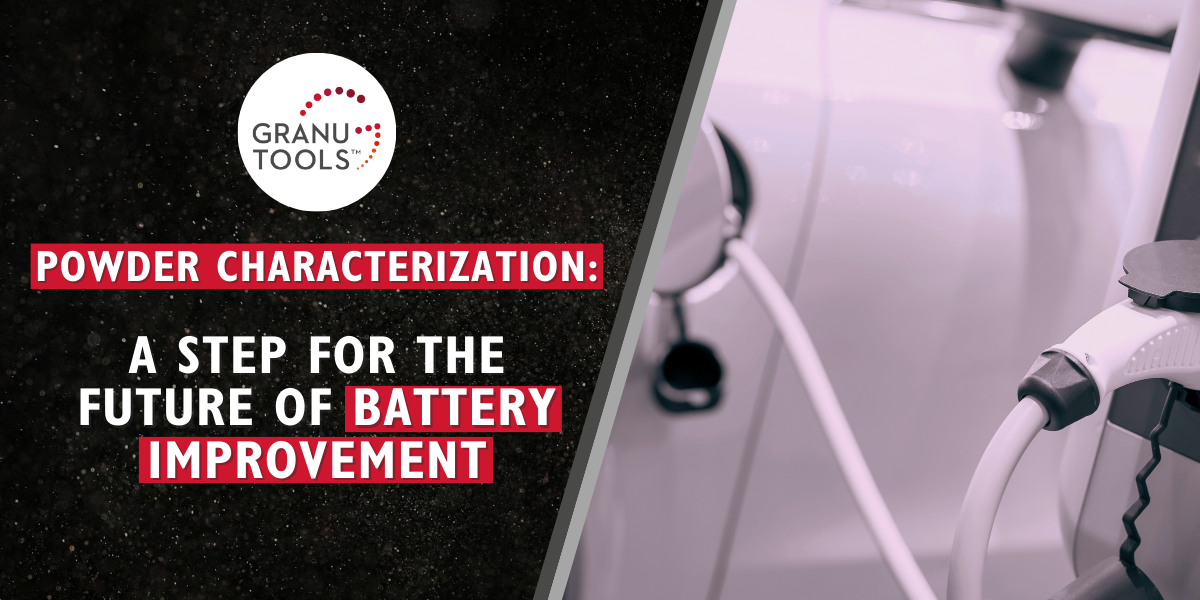Blog
Powder Characterization: A Step for the Future of Battery Improvement
In this article, we explain the importance of powder flow characterization for battery manufacturing using instruments such as the GranuDrum, the GranuCharge and the GranuPack.
Introduction: Why Using Powder Characterization to Improve Dry Processes
Dry processes for electrode manufacturing are the future of battery production. Indeed, contrary to conventional processes that need slurries to coat the current collector with the active materials, dry processes remove the use of solvent. This spares a lot of energy and time generally needed for the drying of the spread slurry. Moreover, these solvent are known to be toxic and thus avoiding them has a supplementary beneficial impact on environment. Consequently, dry processes handle battery materials in powder form. These materials generally consist of an active material (Lithium oxide, Sulfur, Graphite, Silicon…), a conductive additive (generally black carbon), and a binder (polyvinylidene fluoride, polytetrafluoroethylene, polypropylene…).
Each material has its role in the battery and also its own flow behavior. As the powder material employed for electrode manufacturing is a mixture of these three components, the flowability and the bulk properties of the blend will depend on the behavior and the proportion of each constituent. Therefore, it can be challenging to predict the global behavior of this mixture and its effect on the manufacturing process. Consequently, it is important to characterize the behavior of such powder materials to avoid issues and improve the dry process.
Learn more about our instruments
Powder Flow Instruments For Dry Electrode Manufacturing
The powder must have adequate flow properties to reach the requirements of the manufacturing process which influences the final quality of the electrode. These requirements are different depending on the considered dry process.
For instance, for dry coating methods, polytetrafluoroethylene (PTFE) binder is added to the powder blend, and fibrillated. This step is a process consisting in creating fibrils from the agglomerated PTFE binder. This directly affects the flowability of the powder which must show an adequate degree of fibrillation for good electrode consistency. Therefore, it is important to characterize and quantify this degree of fibrillation and its impact on material flowability.
The tapped density analyzer, the GranuPack, and the powder rheometer based on the rotating drum method, the GranuDrum, are the adequate instruments to investigate the powder flowability from quasi-static to dynamic shear states. In addition, the GranuPack and the GranuDrum can perform measurements at specific temperatures, from room to 200 °C. This possibility is valuable considering that dry coating processes are generally made at temperatures higher than room temperature. Thereby, powder testing can be made at similar conditions of temperature and shear state as a dry coating process.
Another example is the dry painting method using electrostatically charged powder to coat the current collector. The powder is charged and spread with a spray gun on a grounded current collector. The powder should show an adequate charge buildup to give a coating of high quality. The chargeability of the powder is an important parameter to control for improving such a process. Therefore, a method able to quantify the ability of a powder to build up charge during a flow is needed.
The electric charge analyzer, using a Faraday cup to measure the electrostatic charge, the GranuCharge, is specifically designed for this kind of purpose. This instrument allows to evaluate the powder electrostatic charge density before and after a flow, and, by comparing these two quantities, to quantify the chargeability. Furthermore, the GranuCharge gives the possibility to perform measurements at a specific humidity when coupled with the GranuMidity. Since tribocharging in powder is known to be influenced by air humidity, it is important to evaluate the chargeability under the same environmental conditions.
Indeed, some materials, such as Ni-rich cathode active materials, are known to be altered by air humidity, impacting the final performance of the battery. To counter that, electrode manufacturing can be done under dry air conditions, influencing the chargeability of the powder and thus the performance of the dry painting process.
Learn more about our instruments
Conclusion: Powder Flow Characterization is a Step Toward Batteries Improvement
Processes for electrode manufacturing handle more and more directly the raw materials blended in powder form. Therefore, it is crucial to characterize the flowability of such powders for future process improvement. For this purpose, the GranuPack and the GranuDrum are ideal tools to test powder flowability from quasi-static to dynamic flow states and from room temperature to 200 °C, in agreement with the shear rate and the temperature undergone by the powder material in the manufacturing process.
In some specific applications, the GranuCharge provides a useful quantification of powder chargeability, and, combined with the GranuMidity, allows to evaluate the effect of air humidity.
Do you have questions about powder characterization ?

.png)